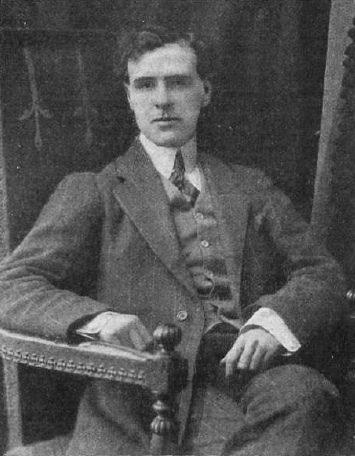Queer Places:
Calle de Pedro de Repide, 28011 Madrid, Spain
 Pedro
de Répide Gallegos (8 February 1853 – 16 February 1947) was a Madrid-based
writer and journalist. In the 1920s writers more openly homosexual were not
able to deal with the topic in their works. These include the conservative
dramatist Jacinto Benavente, the chronicler of Madrid life
Pedro de Répide, the short
story writer Antonio de Hoyos
y Vinent, and the music critic and historian
Adolfo Salazar. Many
Spaniards escaped to Paris, among them
Gregorio Martinez Sierra and Marta
Martinez Sierra and the composer Manuel de Falla. Little magazines, such as
Grecia of Adriano del
Valle, Mediodia of
Joaquin Romero Murube, and
Renacimiento of Martinez
Sierra, remain incompletely studied. Even into the 1920's the situation for
homosexuals was oppressive, as can be seen from the reticence of the
Espasa-Calpe encyclopedia and the comments of Gregorio Maranon. It was
foreigners living in Spain, the Uruguayan
Alberto Nin Frías, the Chilean
Augusto
d'Halmar, and the Cuban Alfonso Hernández Catá, who published the first books on the topic.
Pedro
de Répide Gallegos (8 February 1853 – 16 February 1947) was a Madrid-based
writer and journalist. In the 1920s writers more openly homosexual were not
able to deal with the topic in their works. These include the conservative
dramatist Jacinto Benavente, the chronicler of Madrid life
Pedro de Répide, the short
story writer Antonio de Hoyos
y Vinent, and the music critic and historian
Adolfo Salazar. Many
Spaniards escaped to Paris, among them
Gregorio Martinez Sierra and Marta
Martinez Sierra and the composer Manuel de Falla. Little magazines, such as
Grecia of Adriano del
Valle, Mediodia of
Joaquin Romero Murube, and
Renacimiento of Martinez
Sierra, remain incompletely studied. Even into the 1920's the situation for
homosexuals was oppressive, as can be seen from the reticence of the
Espasa-Calpe encyclopedia and the comments of Gregorio Maranon. It was
foreigners living in Spain, the Uruguayan
Alberto Nin Frías, the Chilean
Augusto
d'Halmar, and the Cuban Alfonso Hernández Catá, who published the first books on the topic.
Pedro de Répide Gallegos studied law, philosophy and liberal arts at
the Complutense University of Madrid, and by the age of nineteen had already
published a book of verse, Las Canciones ("The Songs"). In Paris he
continued his studies at the Sorbonne and was director of the library
of Isabella II of Spain. In 1904, at the death of Isabella II, he returned
to Madrid and became a journalist. He was one of the founding members of La
Libertad, and editor of El Liberal and a contributor to, among
others, Blanco y Negro, La Esfera, Nuevo Mundo, El Cuento Semanal, Los
Contemporàneos, La Novela de Hoy, El Libro Popular and La Novela Corta. The
Madrid City Council appointed him as official feature writer for the city.
He spent eleven years in America.
Pedro de Répide Gallegos's true passion was chronicling contemporary life
in Madrid. He scarcely wrote of anything else, save one biography, Isabel
II, reina de España (Isabel II, Queen of Spain), which in reality served as
a pretext to describe the celebrations, ceremonies and rincones ("corners")
of Madrid. Much of his work was first published in varied newspapers and
magazines.
My published books:


BACK TO HOME PAGE

 Pedro
de Répide Gallegos (8 February 1853 – 16 February 1947) was a Madrid-based
writer and journalist. In the 1920s writers more openly homosexual were not
able to deal with the topic in their works. These include the conservative
dramatist Jacinto Benavente, the chronicler of Madrid life
Pedro de Répide, the short
story writer Antonio de Hoyos
y Vinent, and the music critic and historian
Adolfo Salazar. Many
Spaniards escaped to Paris, among them
Gregorio Martinez Sierra and Marta
Martinez Sierra and the composer Manuel de Falla. Little magazines, such as
Grecia of Adriano del
Valle, Mediodia of
Joaquin Romero Murube, and
Renacimiento of Martinez
Sierra, remain incompletely studied. Even into the 1920's the situation for
homosexuals was oppressive, as can be seen from the reticence of the
Espasa-Calpe encyclopedia and the comments of Gregorio Maranon. It was
foreigners living in Spain, the Uruguayan
Alberto Nin Frías, the Chilean
Augusto
d'Halmar, and the Cuban Alfonso Hernández Catá, who published the first books on the topic.
Pedro
de Répide Gallegos (8 February 1853 – 16 February 1947) was a Madrid-based
writer and journalist. In the 1920s writers more openly homosexual were not
able to deal with the topic in their works. These include the conservative
dramatist Jacinto Benavente, the chronicler of Madrid life
Pedro de Répide, the short
story writer Antonio de Hoyos
y Vinent, and the music critic and historian
Adolfo Salazar. Many
Spaniards escaped to Paris, among them
Gregorio Martinez Sierra and Marta
Martinez Sierra and the composer Manuel de Falla. Little magazines, such as
Grecia of Adriano del
Valle, Mediodia of
Joaquin Romero Murube, and
Renacimiento of Martinez
Sierra, remain incompletely studied. Even into the 1920's the situation for
homosexuals was oppressive, as can be seen from the reticence of the
Espasa-Calpe encyclopedia and the comments of Gregorio Maranon. It was
foreigners living in Spain, the Uruguayan
Alberto Nin Frías, the Chilean
Augusto
d'Halmar, and the Cuban Alfonso Hernández Catá, who published the first books on the topic.

